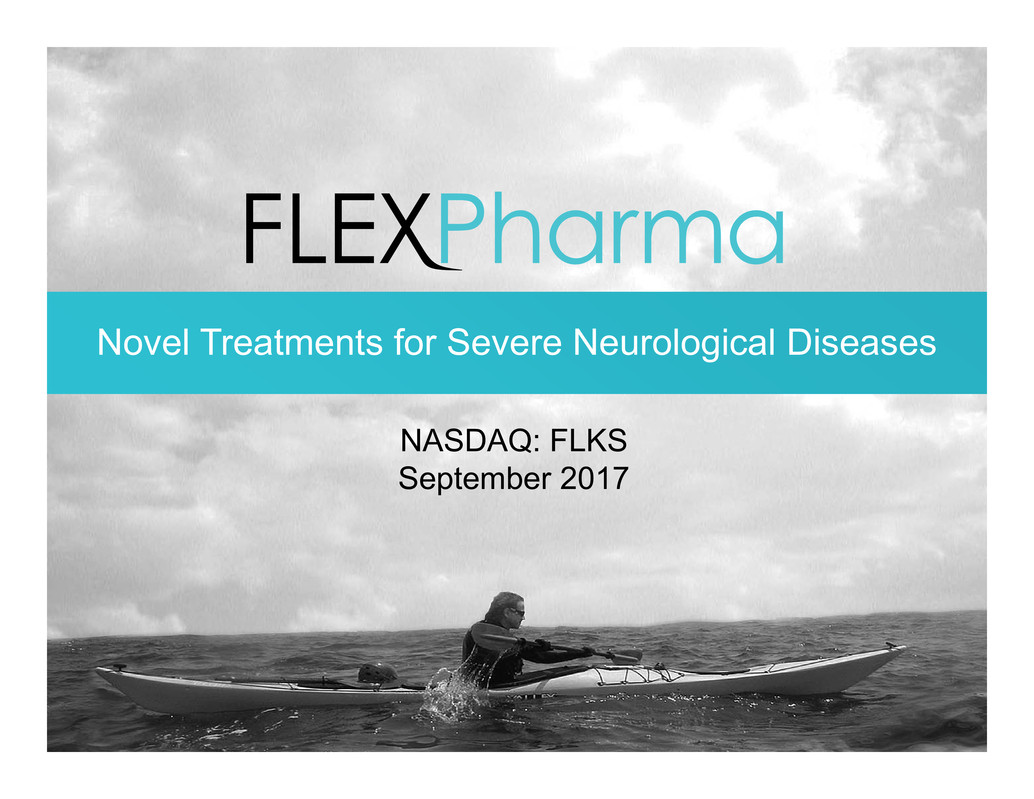
Novel Treatments for Severe Neurological Diseases NASDAQ: FLKS September 2017
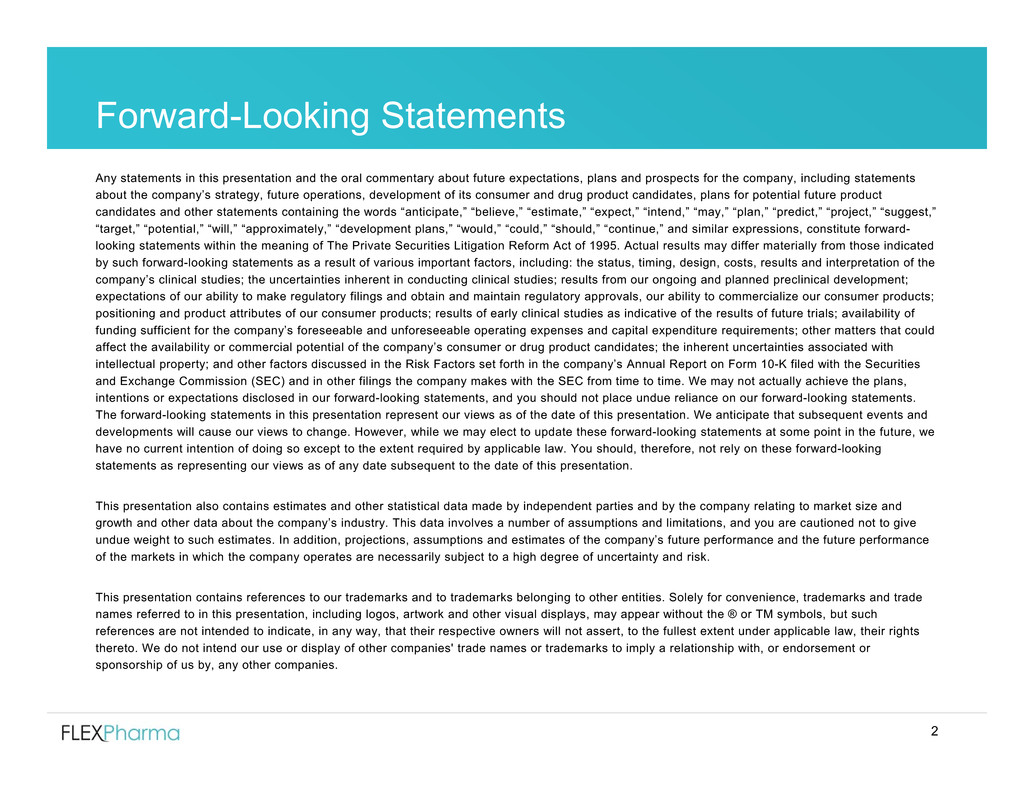
2 Any statements in this presentation and the oral commentary about future expectations, plans and prospects for the company, including statements about the company’s strategy, future operations, development of its consumer and drug product candidates, plans for potential future product candidates and other statements containing the words “anticipate,” “believe,” “estimate,” “expect,” “intend,” “may,” “plan,” “predict,” “project,” “suggest,” “target,” “potential,” “will,” “approximately,” “development plans,” “would,” “could,” “should,” “continue,” and similar expressions, constitute forward- looking statements within the meaning of The Private Securities Litigation Reform Act of 1995. Actual results may differ materially from those indicated by such forward-looking statements as a result of various important factors, including: the status, timing, design, costs, results and interpretation of the company’s clinical studies; the uncertainties inherent in conducting clinical studies; results from our ongoing and planned preclinical development; expectations of our ability to make regulatory filings and obtain and maintain regulatory approvals, our ability to commercialize our consumer products; positioning and product attributes of our consumer products; results of early clinical studies as indicative of the results of future trials; availability of funding sufficient for the company’s foreseeable and unforeseeable operating expenses and capital expenditure requirements; other matters that could affect the availability or commercial potential of the company’s consumer or drug product candidates; the inherent uncertainties associated with intellectual property; and other factors discussed in the Risk Factors set forth in the company’s Annual Report on Form 10-K filed with the Securities and Exchange Commission (SEC) and in other filings the company makes with the SEC from time to time. We may not actually achieve the plans, intentions or expectations disclosed in our forward-looking statements, and you should not place undue reliance on our forward-looking statements. The forward-looking statements in this presentation represent our views as of the date of this presentation. We anticipate that subsequent events and developments will cause our views to change. However, while we may elect to update these forward-looking statements at some point in the future, we have no current intention of doing so except to the extent required by applicable law. You should, therefore, not rely on these forward-looking statements as representing our views as of any date subsequent to the date of this presentation. This presentation also contains estimates and other statistical data made by independent parties and by the company relating to market size and growth and other data about the company’s industry. This data involves a number of assumptions and limitations, and you are cautioned not to give undue weight to such estimates. In addition, projections, assumptions and estimates of the company’s future performance and the future performance of the markets in which the company operates are necessarily subject to a high degree of uncertainty and risk. This presentation contains references to our trademarks and to trademarks belonging to other entities. Solely for convenience, trademarks and trade names referred to in this presentation, including logos, artwork and other visual displays, may appear without the ® or TM symbols, but such references are not intended to indicate, in any way, that their respective owners will not assert, to the fullest extent under applicable law, their rights thereto. We do not intend our use or display of other companies' trade names or trademarks to imply a relationship with, or endorsement or sponsorship of us by, any other companies. Forward-Looking Statements

3 Chemical neurostimulation, a therapy based upon novel TRP ion channel biology from our co-founders (MacKinnon Nobel Prize 2003). Insights in neuromuscular physiology led to a potential treatment for severe and debilitating muscle cramps and spasticity in neurodegenerative diseases Focus on Severe Neurological diseases with FLX-787: • Exploratory MS Spasticity (Australia) • ALS Phase 2 (US Fast Track Designation) - ≈ 20k patients in US1 • CMT Phase 2 (US) initiating Q3 2017 - ≈ 150k patients in US2 Human safety & efficacy assessed in electrically-induced cramps (EIC) and spontaneous, nocturnal leg cramps (NLC) in human subjects: • EIC model produced sigmoidal dose response curve (p<0.05) • Efficacy signals in randomized, blinded, controlled, POC studies with FLX-787 in subjects with NLC • Safety and tolerability assessed in 200+ subjects 1 ALS Association / 2 Epidemiologic Study of Charcot-Marie-Tooth Disease: A Systematic Review. Neuroepidemiology 2016; 46:157-165. NIH National Library of Medicine / Flex Pharma Overview
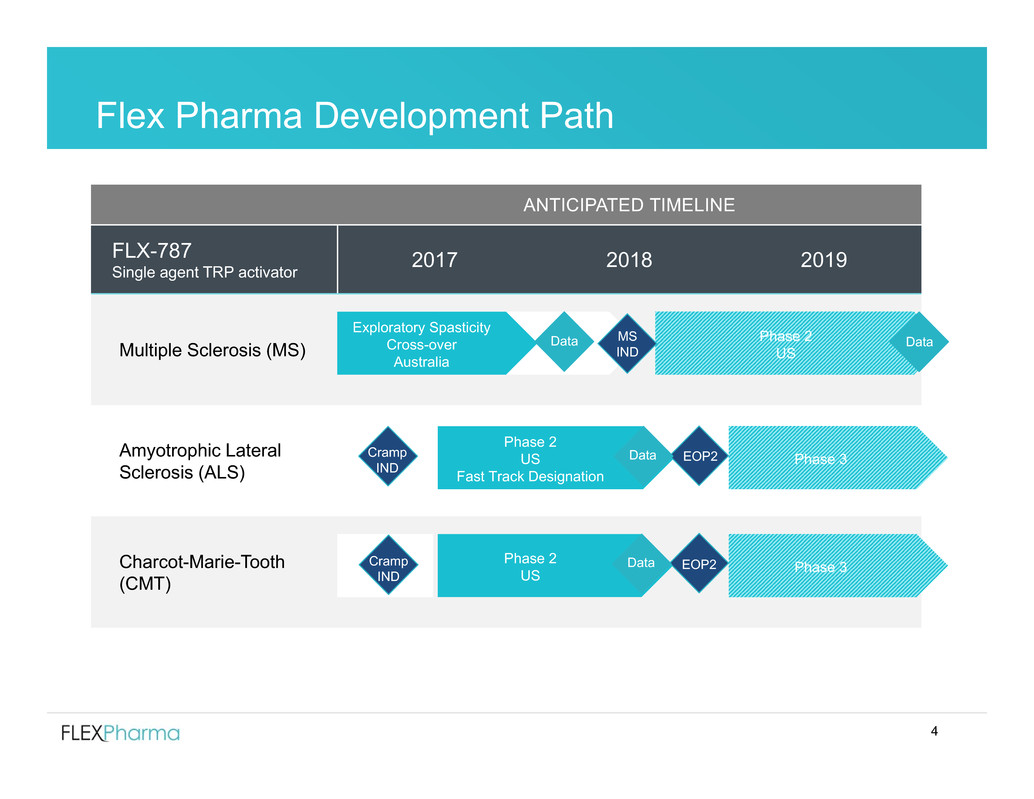
4 ANTICIPATED TIMELINE FLX-787 Single agent TRP activator 2017 2018 2019 Multiple Sclerosis (MS) Amyotrophic Lateral Sclerosis (ALS) Charcot-Marie-Tooth (CMT) Flex Pharma Development Path Phase 3 Exploratory Spasticity Cross-over Australia Spasticity IND Phase 2 US Cramp IND Phase 2 US Fast Track Designation Phase 3Phase 2US Data EOP2 EOP2 Data Data Data MS IND Cramp IN Cramp IND
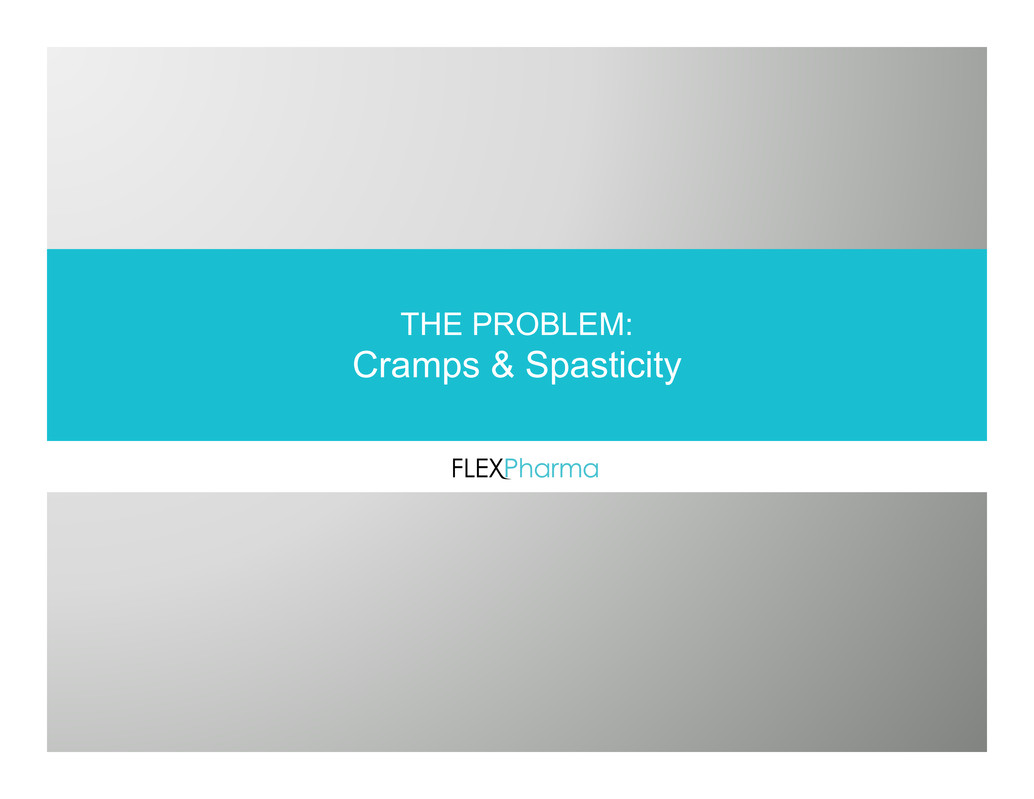
THE PROBLEM: Cramps & Spasticity

6 No FDA approved treatment 95% of ALS patients report cramps1 Cramps can be frequent: median of 4 cramps/day 2 55% of ALS patients with pain attributed that pain to muscle cramps 3 57% of ALS patients to seek treatments directed at limiting cramps.4 Cramping interferes with sleep and reduces QoL for patients suffering from degenerative neurological diseases 5 1 Caress, JB, et al, Muscle Nerve. 2016 April;53(4): 513-517./ 2 Stephens HE 2016, Caress JB 2016, Weiss MD 2016, Weber M 2010,/ 3 Bedlack RS, 2009 Stephens, Joyce, Oskarsson. National Study of Muscle Cramps in ALS in the USA, 2016a / 4 Ganzini et al, Correlates of suffering in amyotrophic lateral sclerosis. Neurology 1999 Apr 22;52(7):1434-40. / 5 Hanisch F, Skudlarek A, Berndt J, Kornhuber ME, Brain Behav. 2015 Mar;5(3) FLX-787 granted Fast Track designation for the treatment of severe muscle cramps associated with ALS (July 2017) Severe and Debilitating Muscle Cramps: Significant Morbidity and Medical Need in Neurological Diseases

7 Baclofen • Spasticity Tx, Limited cramp efficacy • Sedating, ataxia (incoordination), memory problems Quinine • Malaria Tx, Not approved for NLC• Black Box warning Mexilitine • Anti-arrhythmia• Black Box warning Benzodiazepines • Sedating, ataxia• Addictive Limitations of Current Cramp Treatments Many patients seek and receive treatments that are ineffective or un-safe1 F r e q u e n c y o f U s e 1 Stephens, Joyce, Oskarsson. National Study of Muscle Cramps in ALS in the USA, 2016a Mexilitine BLACK BOX Increased Mortality excessive mortality or nonfatal cardiac arrest rate (7.7% encainide/flecainide vs. 3% placebo) in asymptomatic non-life-threatening ventricular arrhythmias w/ MI 6 days - 2 years prior; restrict use to life- threatening ventricular arrhythmias, no survival benefit in pts w/o life- threatening arrhythmias Quinine BLACK BOX Hematologic Toxicity serious and life-threatening toxicity incl. thrombocytopenia and HUS/TTP may occur w/ use for nocturnal leg cramp tx or prevention; TTP-assoc. chronic renal impairment reported; risk assoc. w/ nocturnal leg cramp use in absence of evidence of efficacy does not outweigh any potential benefit

The Science
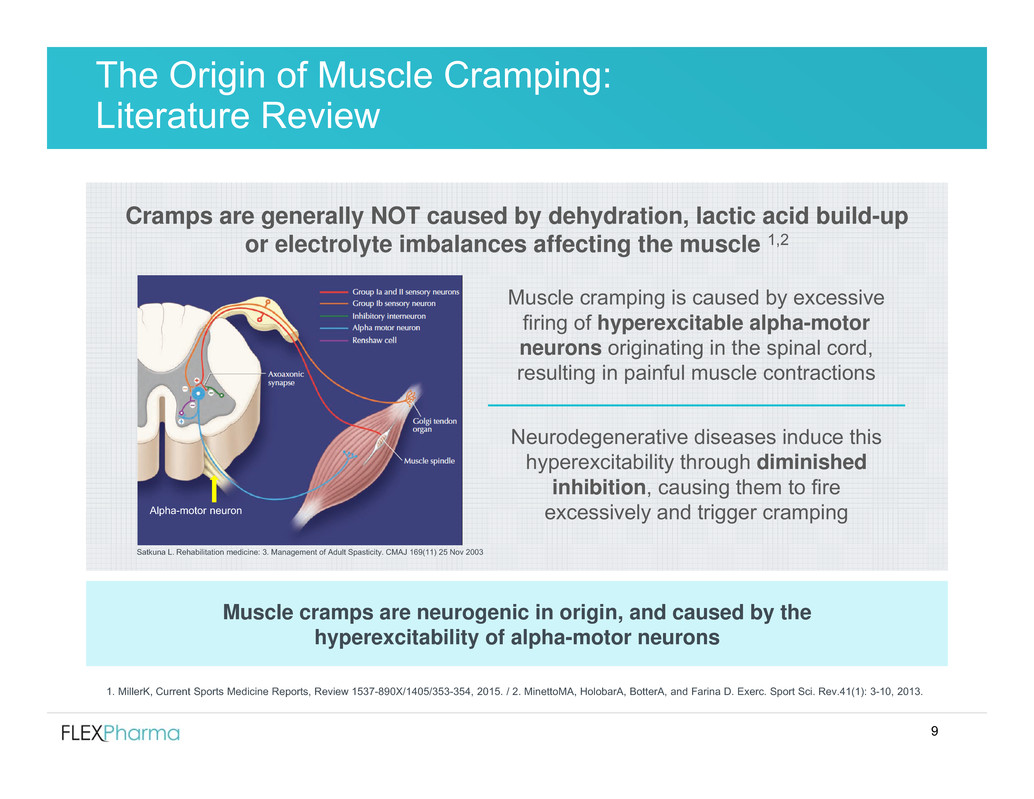
9 The Origin of Muscle Cramping: Literature Review Cramps are generally NOT caused by dehydration, lactic acid build-up or electrolyte imbalances affecting the muscle 1,2 1. MillerK, Current Sports Medicine Reports, Review 1537-890X/1405/353-354, 2015. / 2. MinettoMA, HolobarA, BotterA, and Farina D. Exerc. Sport Sci. Rev.41(1): 3-10, 2013. Muscle cramps are neurogenic in origin, and caused by the hyperexcitability of alpha-motor neurons Muscle cramping is caused by excessive firing of hyperexcitable alpha-motor neurons originating in the spinal cord, resulting in painful muscle contractions Neurodegenerative diseases induce this hyperexcitability through diminished inhibition, causing them to fire excessively and trigger crampingAlpha-motor neuron Satkuna L. Rehabilitation medicine: 3. Management of Adult Spasticity. CMAJ 169(11) 25 Nov 2003

10 Hyperexcitable Motor Neurons from ALS Patients Control-derived ALS-derived Inducible pluripotent stem cell lines from healthy normal and ALS patients were differentiated to motor neurons Stimulated motor neurons from ALS patients were hyperexcitable, relative to controls Wainger BJ, Kiskinis E, Mellin C, Wiskow O, Han SS, Sandoe J, Perez NP, Williams LA, Lee S, Boulting G, Berry JD, Brown RH Jr, Cudkowicz ME, Bean BP, Eggan K, Woolf CJ. Intrinsic membrane hyperexcitability of amyotrophic lateral sclerosis patient-derived motor neurons. Cell Rep. 2014 7:1-11.
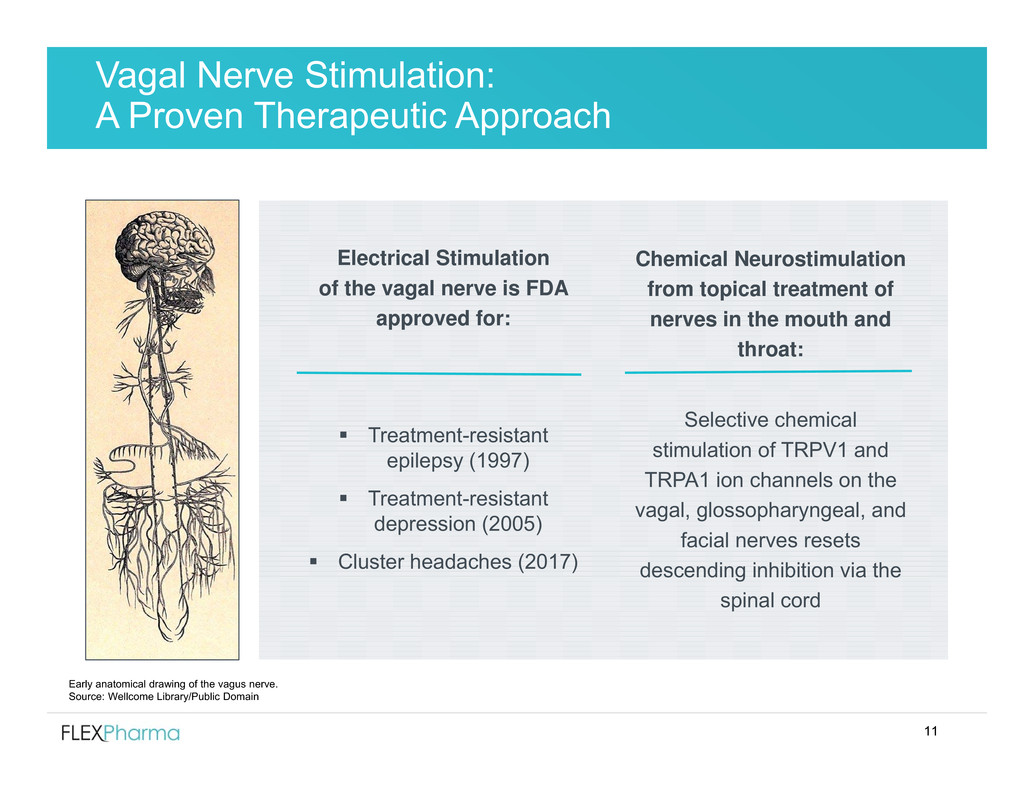
11 Vagal Nerve Stimulation: A Proven Therapeutic Approach Early anatomical drawing of the vagus nerve. Source: Wellcome Library/Public Domain Electrical Stimulation of the vagal nerve is FDA approved for: Treatment-resistant epilepsy (1997) Treatment-resistant depression (2005) Cluster headaches (2017) Chemical Neurostimulation from topical treatment of nerves in the mouth and throat: Selective chemical stimulation of TRPV1 and TRPA1 ion channels on the vagal, glossopharyngeal, and facial nerves resets descending inhibition via the spinal cord
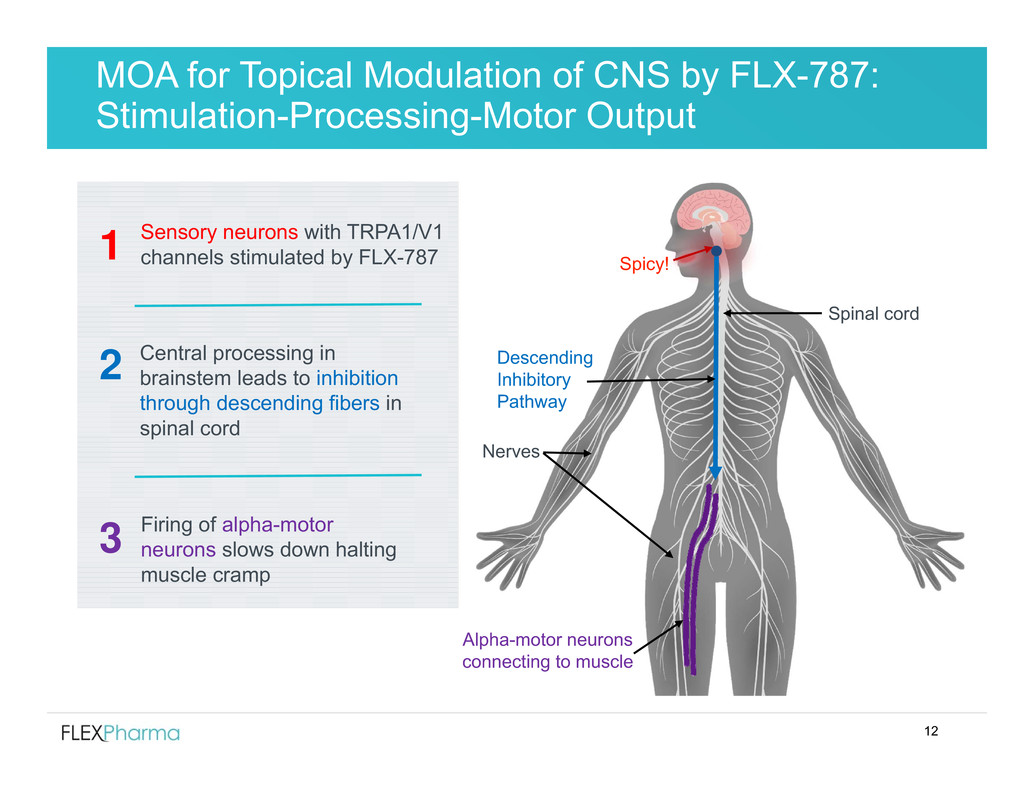
12 MOA for Topical Modulation of CNS by FLX-787: Stimulation-Processing-Motor Output Spicy! Alpha-motor neurons connecting to muscle Spinal cord Descending Inhibitory Pathway Nerves Central processing in brainstem leads to inhibition through descending fibers in spinal cord Sensory neurons with TRPA1/V1 channels stimulated by FLX-787 Firing of alpha-motor neurons slows down halting muscle cramp 1 2 3

13 Muscle Cramping: ALS, CMT, MS, Renal Dialysis, Chemotherapy Induced Nausea, Hereditary Spastic Paraplegia Autonomic Control: Migraine/Cluster Headache, Overactive Bladder, Obstructive Sleep Apnea, Raynaud’s, Gastroparesis, Emesis, Menstrual Cramping Non-autonomic Control (complex motor): Cervical Dystonia, Bruxism, Dysphagia Neuro-Psychiatric: Epilepsy, Depression, PTSD, Tinnitus, Panic Attack Potential Applications of Chemical Neurostimulation 1. Muscaritoli M, et al, Nutrition(2012) 28(10):959–66; 2. Onesti E, et al, Frontiers in Neurology. 2017;8:94; 3. Cook IJ, Kahrillas PJ. Gastroenterology 1999; 116: 455-78.; 4. K Tjaden, Top Geriatr Rehabil. 2008 ; 24(2): 115–126; 5. National Institute on Deafness and Other Communication Disorders [NIDCD], n.d.; Steele, Greenwood, Ens, Robertson, & Seidman-Carlson, 1997; 6. Kawashima, Motohashi, & Fujishima, 2004; 7. Serra-Prat et al., 2011; 8. AHCPR, 1999; 9. Rofes, LJ Gastroenterol (2014) 49:1517–1523; 10.Hirata A, et al, Biol. Pharm. Bull. 39, 1107–1111 (2016) Dysphagia (Difficult/Unsafe Swallowing): • Dysphagia emerges in more than 80% of ALS patients during the advanced phases of the disease1 • Over a ~2 year period, the % of ALS patients suffering from dysphagia increased to 73% in patients with spinal onset and 98% in those with bulbar onset.2 Aspiration pneumonia is a common cause of death in ALS3 • 40% to 95% of persons with Parkinson Disease have dysphagia4 • Up to 38% of the elderly (>65 YOA) living independently, and up to 68% of those in long-term care have dysphagia5,6,7 • 1/3 of patients with dysphagia develop pneumonia each year, and 60k die from their pneumonia8 • TRP channel activators from pepper9 and ginger extracts10 have been shown to improve swallowing in the elderly.

Clinical Development
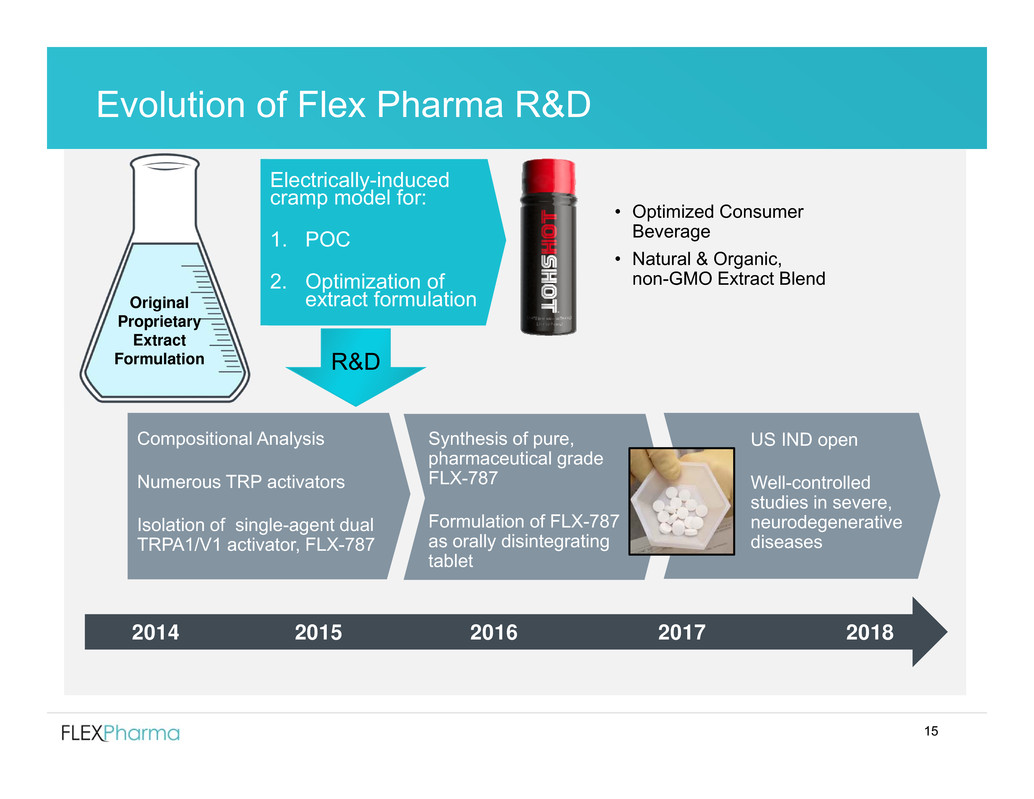
15 Electrically-induced cramp model for: 1. POC 2. Optimization of extract formulation Evolution of Flex Pharma R&D 2014 2015 2016 2017 2018 Compositional Analysis Numerous TRP activators Isolation of single-agent dual TRPA1/V1 activator, FLX-787 • Optimized Consumer Beverage • Natural & Organic, non-GMO Extract Blend Synthesis of pure, pharmaceutical grade FLX-787 Formulation of FLX-787 as orally disintegrating tablet US IND open Well-controlled studies in severe, neurodegenerative diseases Original Proprietary Extract Formulation R&D
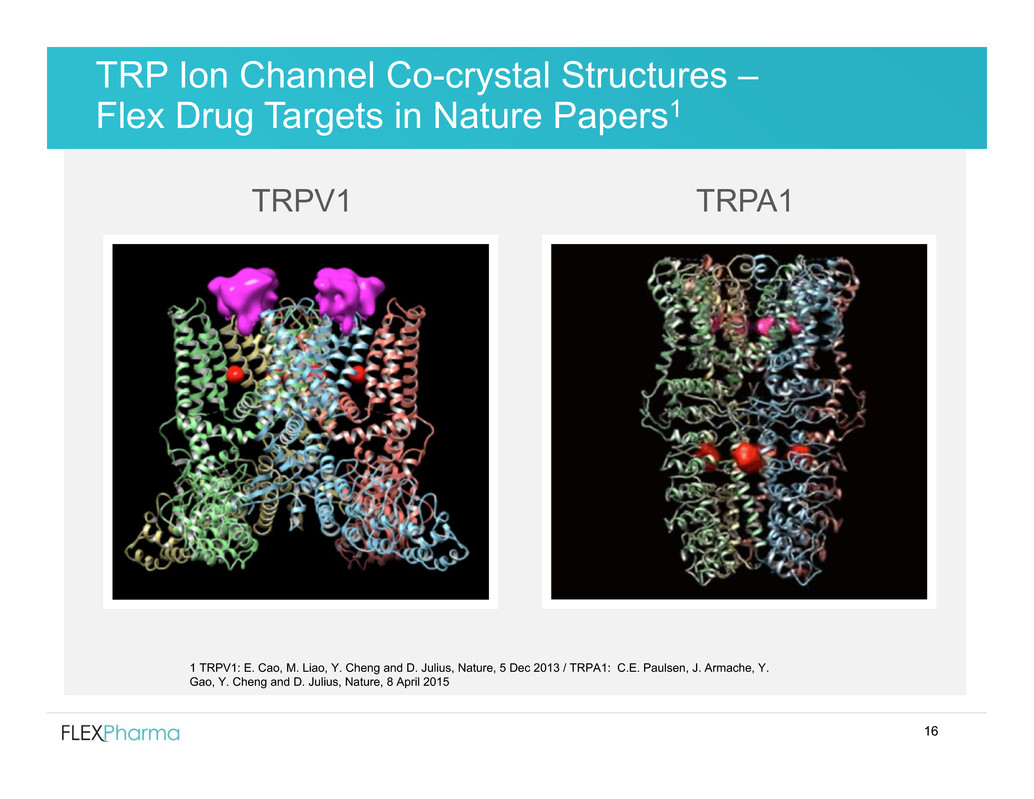
16 TRP Ion Channel Co-crystal Structures – Flex Drug Targets in Nature Papers1 1 TRPV1: E. Cao, M. Liao, Y. Cheng and D. Julius, Nature, 5 Dec 2013 / TRPA1: C.E. Paulsen, J. Armache, Y. Gao, Y. Cheng and D. Julius, Nature, 8 April 2015 TRPA1TRPV1
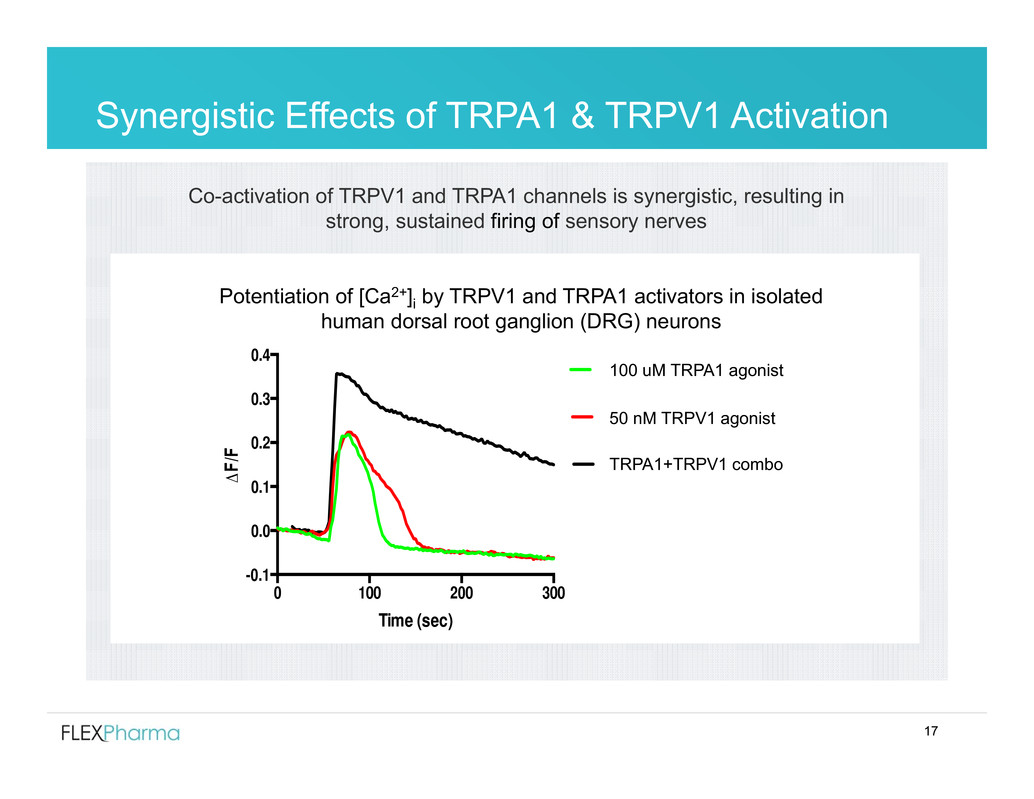
17 Synergistic Effects of TRPA1 & TRPV1 Activation Co-activation of TRPV1 and TRPA1 channels is synergistic, resulting in strong, sustained firing of sensory nerves Potentiation of [Ca2+]i by TRPV1 and TRPA1 activators in isolated human dorsal root ganglion (DRG) neurons 0 100 200 300 -0.1 0.0 0.1 0.2 0.3 0.4 Time (sec) F / F 100 uM TRPA1 agonist 50 nM TRPV1 agonist TRPA1+TRPV1 combo

18 FLX-787: Dose Dependent Inhibition of EIC in HNV Presented at Society for Neuroscience Nov. 15, 2016; Presentation Number: 537.15 • HNV = Healthy Normal Volunteers • AUC = Area under the Curve (intensity & duration) of electromyogram of the cramping muscle (flexor hallucis brevis) • 6 doses of FLX-787 (n=5, p<0.05) 30 mg Phase 2 dose
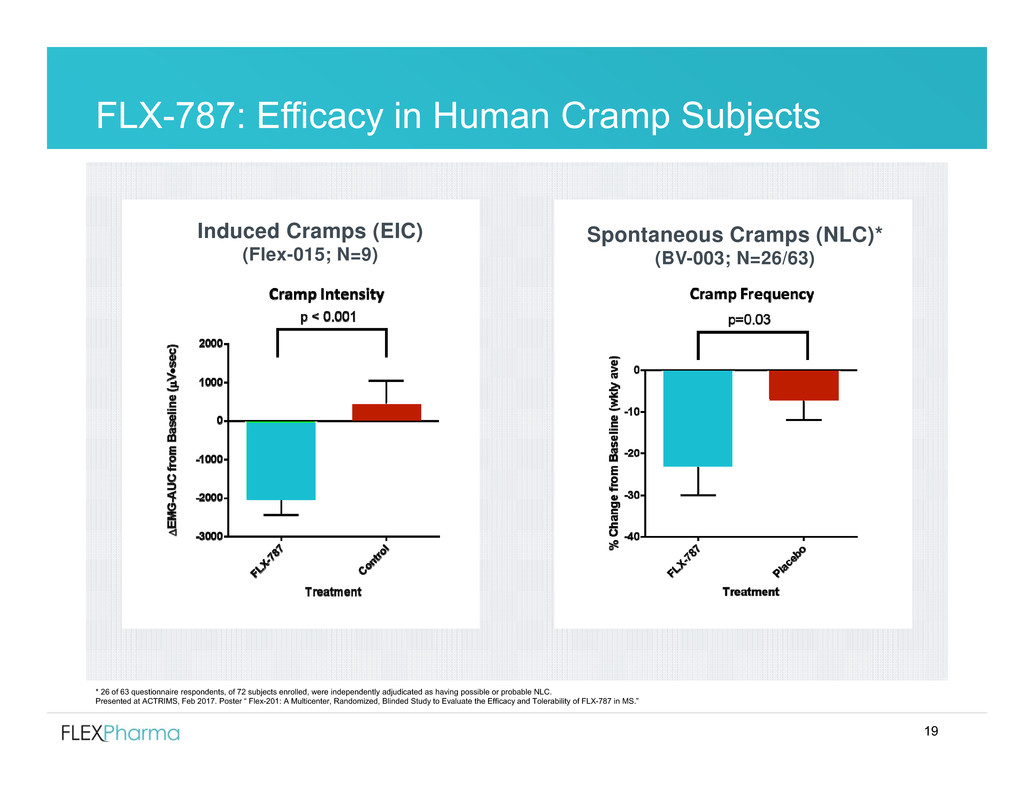
19 FLX-787: Efficacy in Human Cramp Subjects Spontaneous Cramps (NLC)* (BV-003; N=26/63) Induced Cramps (EIC) (Flex-015; N=9) * 26 of 63 questionnaire respondents, of 72 subjects enrolled, were independently adjudicated as having possible or probable NLC. Presented at ACTRIMS, Feb 2017. Poster “ Flex-201: A Multicenter, Randomized, Blinded Study to Evaluate the Efficacy and Tolerability of FLX-787 in MS.”
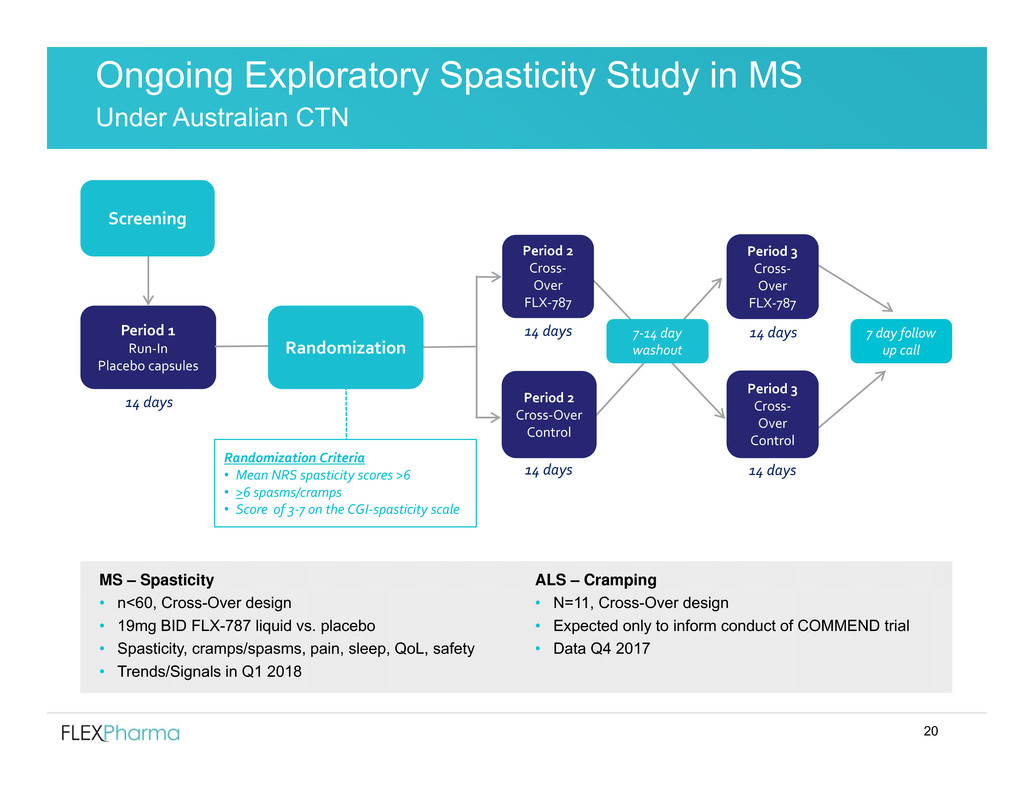
20 Screening Period 1 Run‐In Placebo capsules Period 2 Cross‐ Over FLX‐787 Period 2 Cross‐Over Control 7 day follow up call 14 days 14 days 14 days Period 3 Cross‐ Over Control 14 days Period 3 Cross‐ Over FLX‐787 14 days MS – Spasticity • n<60, Cross-Over design • 19mg BID FLX-787 liquid vs. placebo • Spasticity, cramps/spasms, pain, sleep, QoL, safety • Trends/Signals in Q1 2018 ALS – Cramping • N=11, Cross-Over design • Expected only to inform conduct of COMMEND trial • Data Q4 2017 7‐14 day washout Ongoing Exploratory Spasticity Study in MS Under Australian CTN Randomization Randomization Criteria • Mean NRS spasticity scores >6 • >6 spasms/cramps • Score of 3‐7 on the CGI‐spasticity scale
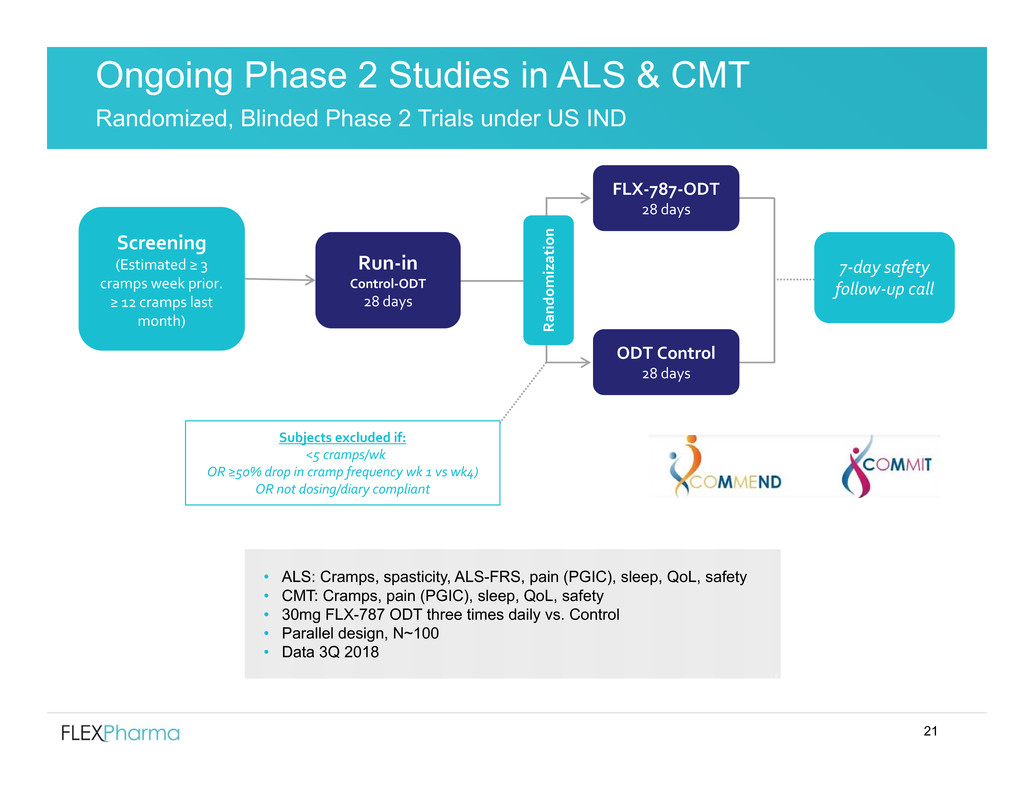
21 Ongoing Phase 2 Studies in ALS & CMT Randomized, Blinded Phase 2 Trials under US IND • ALS: Cramps, spasticity, ALS-FRS, pain (PGIC), sleep, QoL, safety • CMT: Cramps, pain (PGIC), sleep, QoL, safety • 30mg FLX-787 ODT three times daily vs. Control • Parallel design, N~100 • Data 3Q 2018 FLX‐787‐ODT 28 days ODT Control 28 days Subjects excluded if: <5 cramps/wk OR ≥50% drop in cramp frequency wk 1 vs wk4) OR not dosing/diary compliant Screening (Estimated ≥ 3 cramps week prior. ≥ 12 cramps last month) R a n d o m i z a t i o n Run‐in Control‐ODT 28 days 7‐day safety follow‐up call
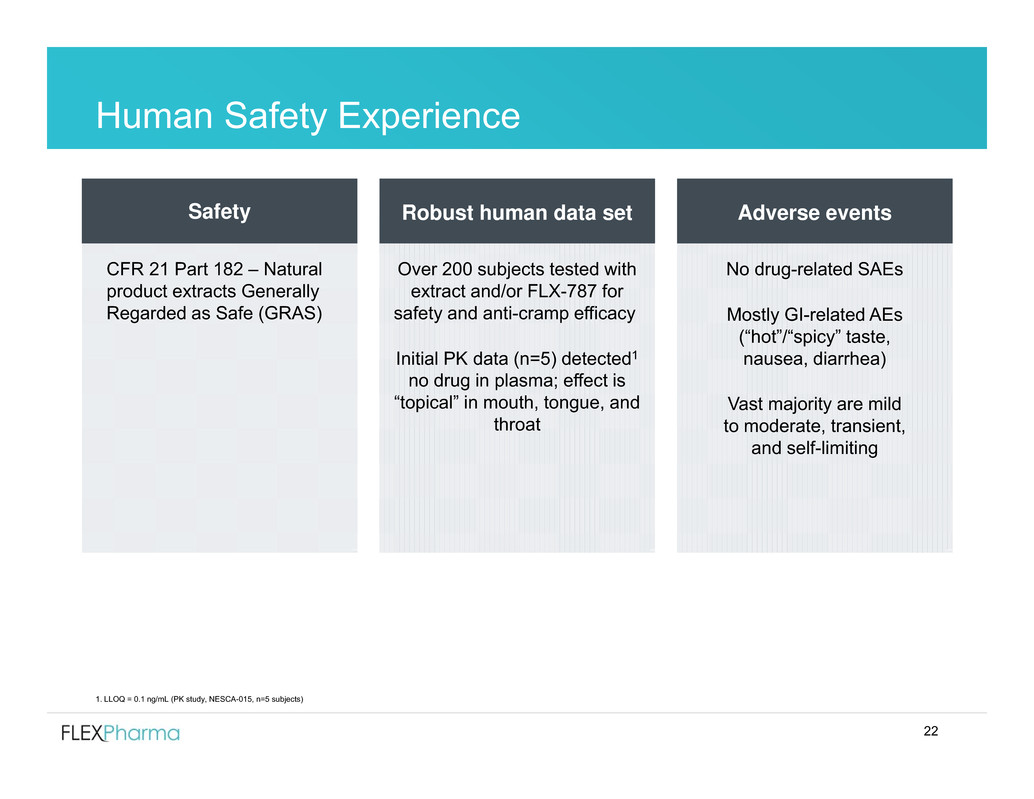
22 Safety Over 200 subjects tested with extract and/or FLX-787 for safety and anti-cramp efficacy Initial PK data (n=5) detected1 no drug in plasma; effect is “topical” in mouth, tongue, and throat Robust human data set No drug-related SAEs Mostly GI-related AEs (“hot”/“spicy” taste, nausea, diarrhea) Vast majority are mild to moderate, transient, and self-limiting Adverse events Human Safety Experience 1. LLOQ = 0.1 ng/mL (PK study, NESCA-015, n=5 subjects) CFR 21 Part 182 – Natural product extracts Generally Regarded as Safe (GRAS)
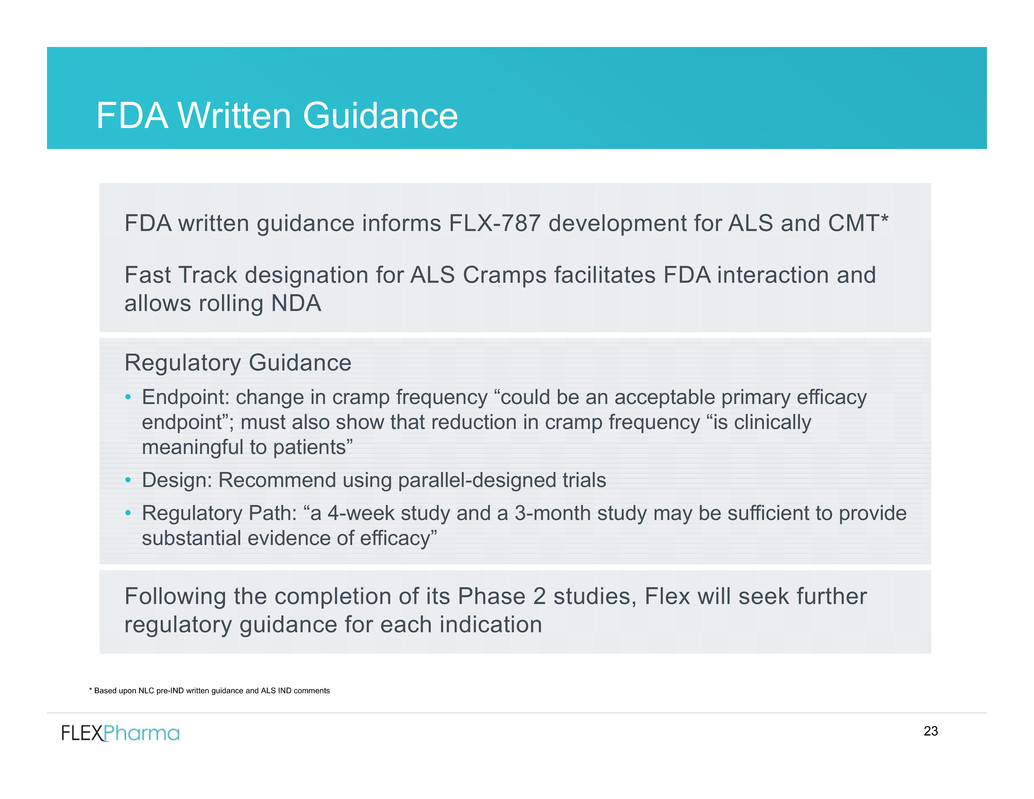
23 FDA Written Guidance FDA written guidance informs FLX-787 development for ALS and CMT* Fast Track designation for ALS Cramps facilitates FDA interaction and allows rolling NDA Regulatory Guidance • Endpoint: change in cramp frequency “could be an acceptable primary efficacy endpoint”; must also show that reduction in cramp frequency “is clinically meaningful to patients” • Design: Recommend using parallel-designed trials • Regulatory Path: “a 4-week study and a 3-month study may be sufficient to provide substantial evidence of efficacy” Following the completion of its Phase 2 studies, Flex will seek further regulatory guidance for each indication * Based upon NLC pre-IND written guidance and ALS IND comments

24 Management Team • William McVicar, PhD, President & CEO; Sandoz/Novartis, Rhone Poulenc Rorer, Sepracor, Inotek • David Golod, PhD, VP Clinical Operations; Vertex • Rob Hadfield, General Counsel; Cooley LLP, Kiva Systems, SG Cowen • John McCabe, CFO; Ariad, Charles River Associates, Biogen, Arthur Andersen • Glenn Short, PhD, VP, Non-Clinical and Translational Research; CombinatoRx, Zalicus • Angelene Simonello, VP Corporate and Program Development; Viacell, Biogen • Thomas Wessel, MD PhD, CMO; J&J (Razadyne®), Sepracor (Lunesta®), Acorda (Ampyra®) • Elizabeth Woo, SVP, Investor Relations; Biogen, Ironwood, Cubist Board of Directors • Christoph Westphal, MD PhD, Chairman; Cofounder/Lead investor ALNY MNTA XLRN SIRT Alnara CNCE VSTM OVAS • Jeff Capello, CFO Beacon Health; BOD OVAS, former Boston Scientific CFO, PKI, PWC • Peter Barton Hutt, former Chief Counsel FDA; Sirtris, Momenta, Concert, Covington and Burling • Marc Kozin, LEK Consulting, former President of North American practice; BOD OVAS, ECYT, DYAX, UFPT • Rod MacKinnon, MD, Co-founder, Chair, SAB; Nobel Prize 2003, ion channels; Professor, Rockefeller; NAS • Rob Perez, former CEO Cubist; former Biogen, BOD AMAG, CDTX • Stuart Randle, Ivenix CEO, former CEO GI Dynamics, former CEO ACT Medical, Baxter • Michelle Stacy, former Keurig President, Gillette/P&G, BOD iRobot Management Team and Board of Directors
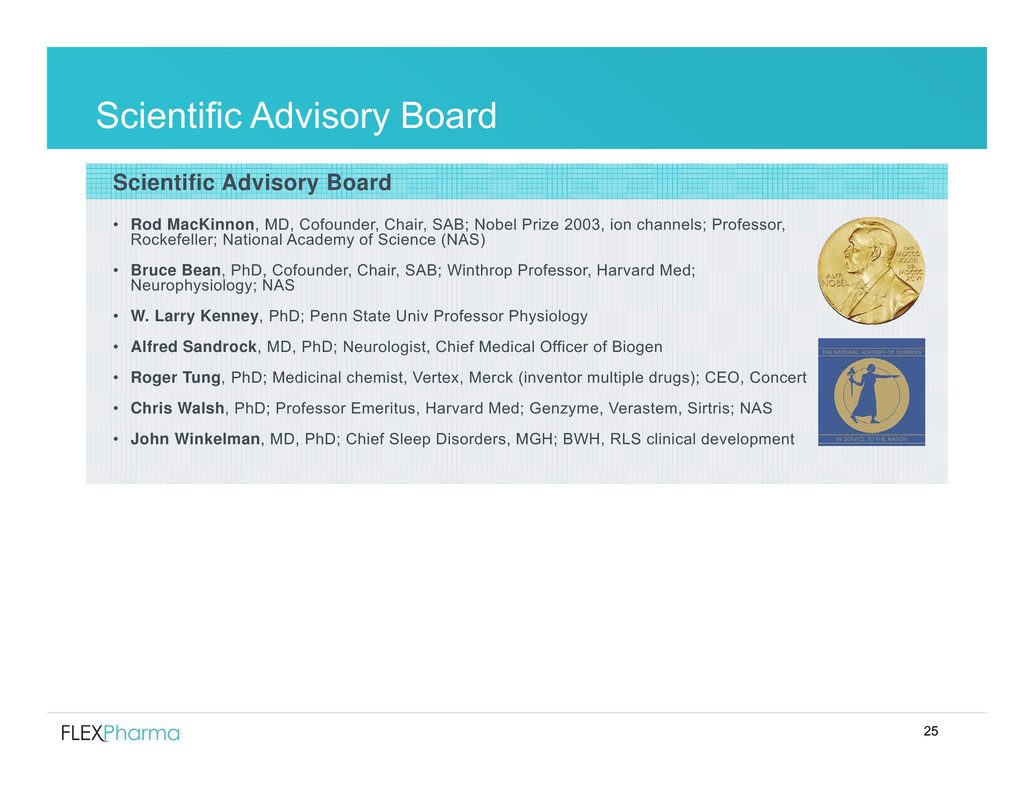
25 Scientific Advisory Board Scientific Advisory Board • Rod MacKinnon, MD, Cofounder, Chair, SAB; Nobel Prize 2003, ion channels; Professor, Rockefeller; National Academy of Science (NAS) • Bruce Bean, PhD, Cofounder, Chair, SAB; Winthrop Professor, Harvard Med; Neurophysiology; NAS • W. Larry Kenney, PhD; Penn State Univ Professor Physiology • Alfred Sandrock, MD, PhD; Neurologist, Chief Medical Officer of Biogen • Roger Tung, PhD; Medicinal chemist, Vertex, Merck (inventor multiple drugs); CEO, Concert • Chris Walsh, PhD; Professor Emeritus, Harvard Med; Genzyme, Verastem, Sirtris; NAS • John Winkelman, MD, PhD; Chief Sleep Disorders, MGH; BWH, RLS clinical development
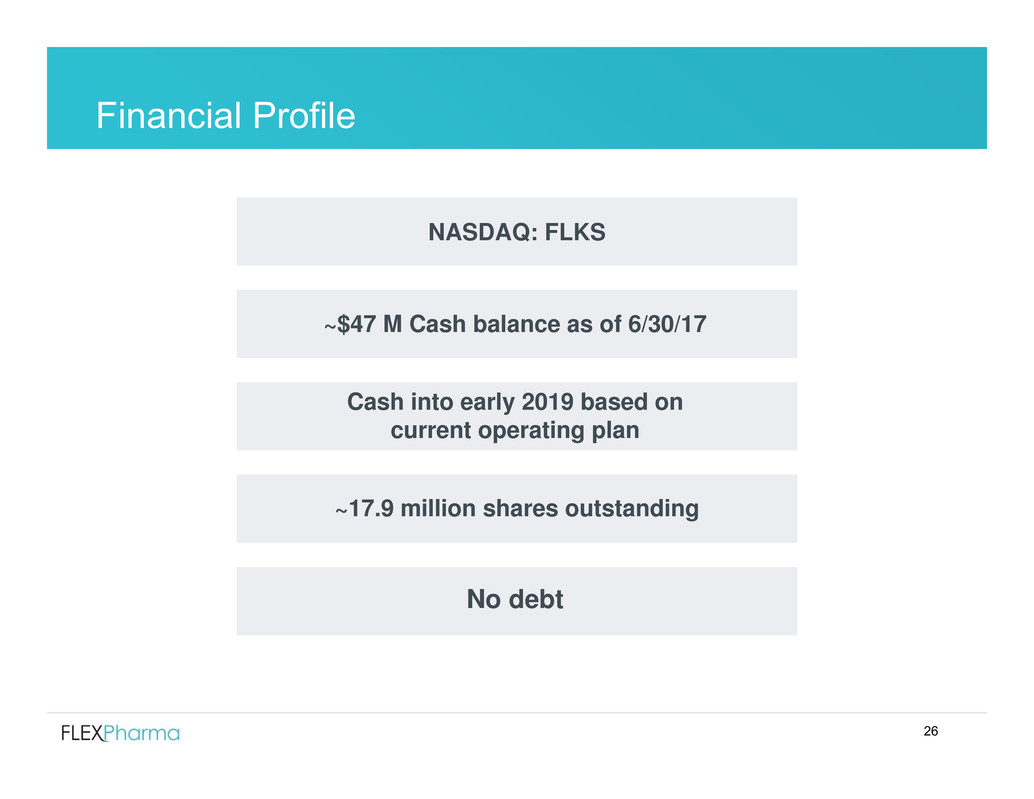
26 Financial Profile NASDAQ: FLKS ~$47 M Cash balance as of 6/30/17 Cash into early 2019 based on current operating plan ~17.9 million shares outstanding No debt
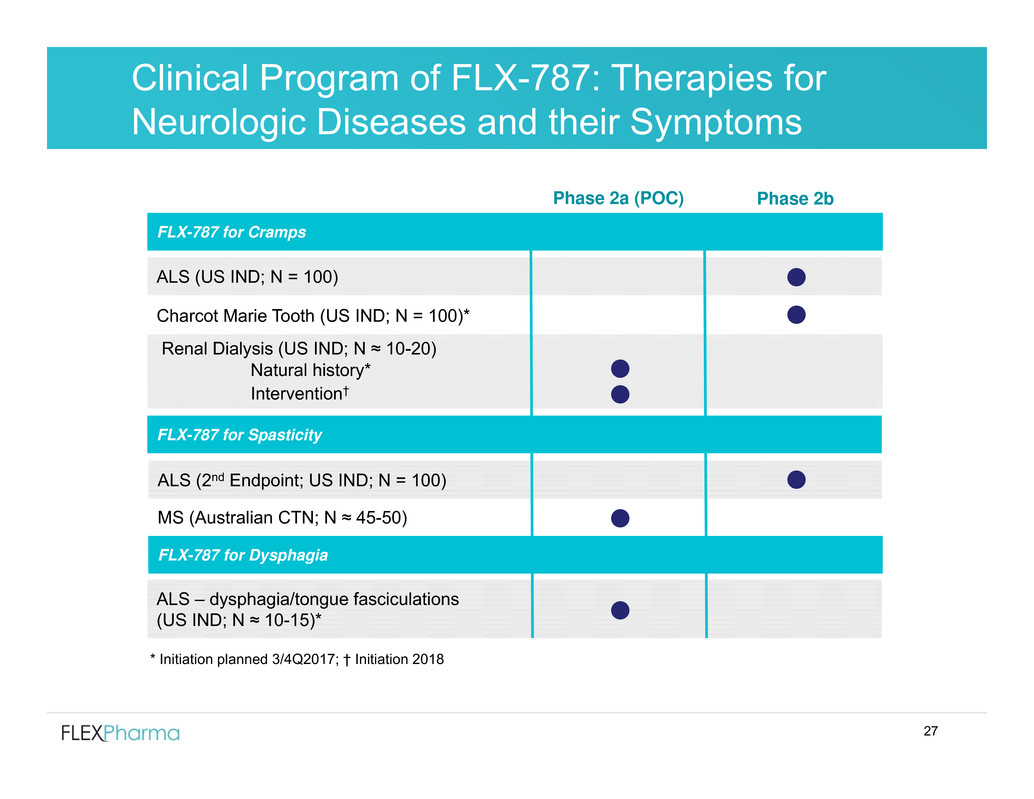
27 Phase 2a (POC) Phase 2b ALS (US IND; N = 100) ALS (2nd Endpoint; US IND; N = 100) FLX-787 for Cramps FLX-787 for Spasticity MS (Australian CTN; N ≈ 45-50) Charcot Marie Tooth (US IND; N = 100)* FLX-787 for Dysphagia ALS – dysphagia/tongue fasciculations (US IND; N ≈ 10-15)* Renal Dialysis (US IND; N ≈ 10-20) Natural history* Intervention† Clinical Program of FLX-787: Therapies for Neurologic Diseases and their Symptoms * Initiation planned 3/4Q2017; † Initiation 2018
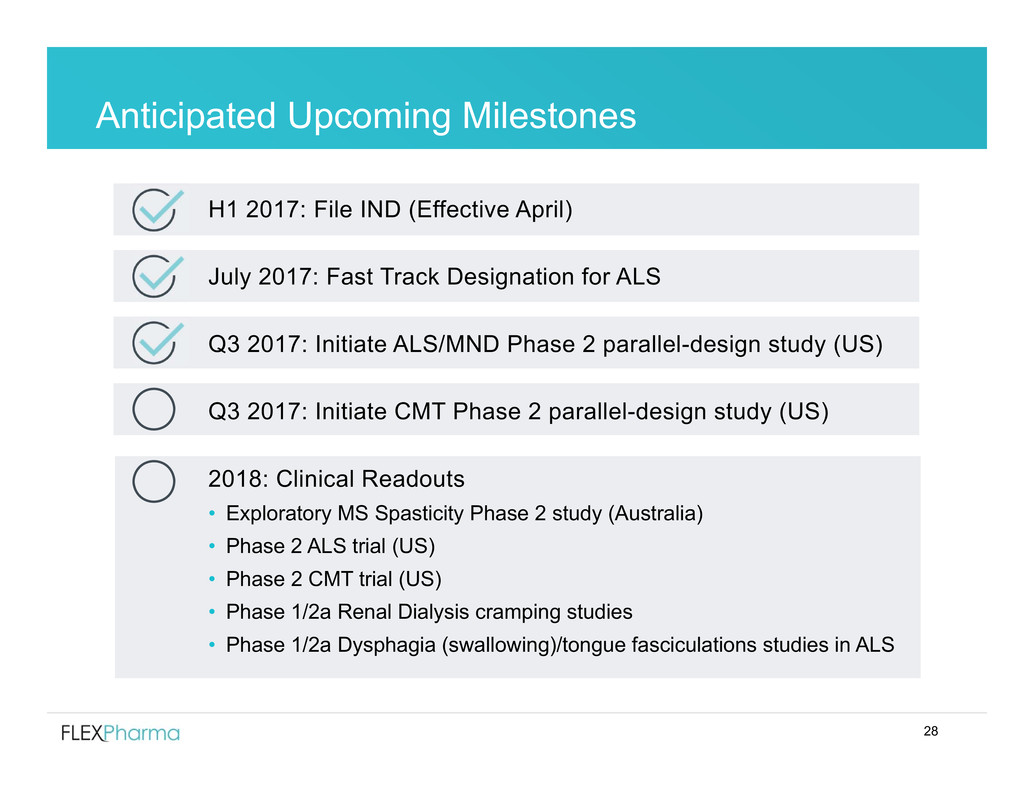
28 Anticipated Upcoming Milestones H1 2017: File IND (Effective April) July 2017: Fast Track Designation for ALS Q3 2017: Initiate ALS/MND Phase 2 parallel-design study (US) Q3 2017: Initiate CMT Phase 2 parallel-design study (US) 2018: Clinical Readouts • Exploratory MS Spasticity Phase 2 study (Australia) • Phase 2 ALS trial (US) • Phase 2 CMT trial (US) • Phase 1/2a Renal Dialysis cramping studies • Phase 1/2a Dysphagia (swallowing)/tongue fasciculations studies in ALS
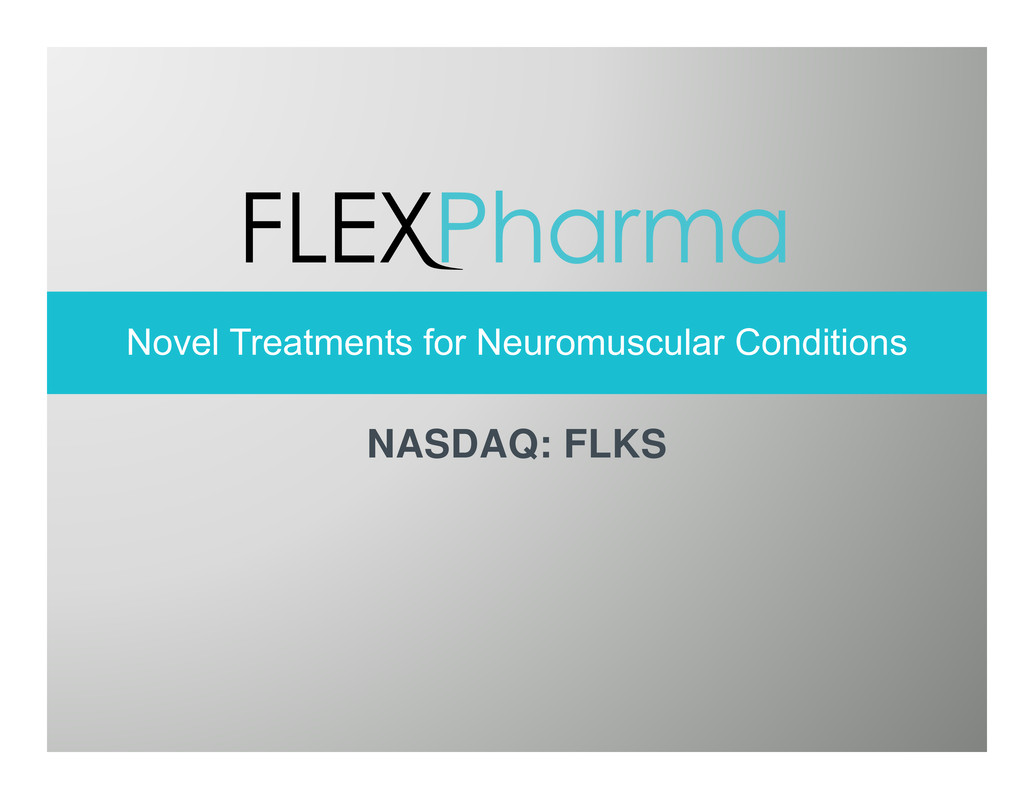
Novel Treatments for Neuromuscular Conditions NASDAQ: FLKS




























